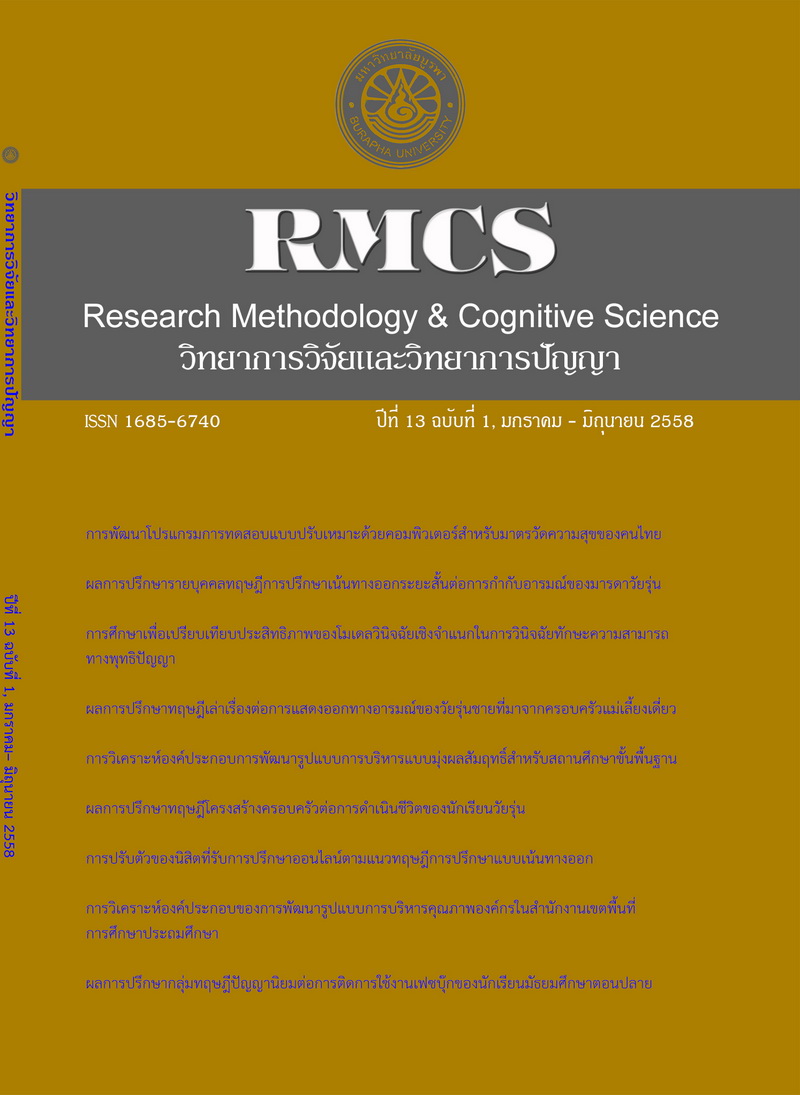การศึกษาเพื่อเปรียบเทียบประสิทธิภาพของโมเดลวินิจฉัยเชิงจำแนกในการวินิจฉัยทักษะความสามารถทางพุทธิปัญญา
Main Article Content
Abstract
การวิจัยนี้มีวัตถุประสงค์เพื่อศึกษาและเปรียบเทียบประสิทธิภาพของโมเดลที่นำมาใช้ในการวินิจฉัย ทักษะความสามารถทางพุทธิปัญญา ในการแก้ปัญหาเรื่องสมการเชิงเส้นตัวแปรเดียวของนักเรียนระดับชั้น มัธยมศึกษาตอนต้นรวมทุกระดับชั้น และกลุ่มของนักเรียนที่มีระดับชั้น เพศ และแผนการเรียน แตกต่างกัน วิธีดำเนินการวิจัยได้นำแบบทดสอบที่ใช้ในการประเมินเพื่อวินิจฉัยทักษะความสามารถทางพุทธิปัญญาของ นักเรียนระดับชั้นมัธยมศึกษาตอนต้น ในการแก้ปัญหาเรื่องสมการเชิงเส้นตัวแปรเดียว ซึ่งพัฒนาขึ้นด้วยวิธีการตาม แนวคิดของ Embretson’s Cognitive Design System Approach (CDS Framework) ไปใช้สอบกับนักเรียน จำนวน 1,214 คน และทำการวิเคราะห์ข้อมูลเพื่อเปรียบเทียบประสิทธิภาพของโมเดลการวินิจฉัยเชิงจำแนก คือ G–DINA Model และ DINA Model ตามตัวแปรปัจจัยที่ส่งผลต่อความแตกต่างของความสามารถในการใช้ทักษะ ทางพุทธิปัญญาเพื่อการหาคำตอบของปัญหา ผลการวิจัยปรากฏว่า G–DINA Model เป็นโมเดลที่ให้ค่าดัชนีความ สอดคล้องของโมเดลในเชิงสัมบูรณ์และค่าดัชนีความสอดคล้องของโมเดลในเชิงสัมพัทธ์ต่ำกว่าค่าที่ได้จาก DINA Model ในทุกเงื่อนไขของการวิเคราะห์ แสดงให้เห็นว่า G–DINA Model เป็นโมเดลที่ให้ประสิทธิภาพในการ วิเคราะห์ข้อมูลในเชิงการวินิจฉัยดีกว่า DINA Model ทั้งการวิเคราะห์กับกลุ่มนักเรียนระดับชั้นมัธยมศึกษา ตอนต้นรวมทุกระดับชั้น การวิเคราะห์กับกลุ่มของนักเรียนที่มีระดับชั้น เพศ และแผนการเรียน แตกต่างกัน
The Study for Comparing the Efficiency of Diagnostic Classification Models
Sumalee Meesakul, Ong–art Naiyapatana , Chusak Khampalikit and Suwimon Kritkharuehart
Faculty of Education, Srinakharinwirot University, Thailand
The main purpose of this research study was to compare the efficiency of diagnostic classification models for using to diagnose the lower secondary school students’ cognitive skills in solving the linear equation problems. The diagnostic test, which was developed by using Embretson's Cognitive Design System Approach (or CDS framework), was used to administer 1,214 lower secondary school students. Data from the assessment were analyzed by using two diagnostic classification models, G–DINA and DINA model in the four conditions. The first condition, all data were analyzed by G–DINA and DINA model. The second condition, the data were classified in three groups of student’s level (1st grade, 2rd grade, and 3nd grade). The third condition, the data were classified in two group of student’s gender (male and female). The fourth condition, the data were classified in two group of student’s academic plan (sciences–mathematics plan and general plan). The results showed the absolute fit index and the relative fit index of G–DINA model was lower than these of DINA model was in all conditions, therefore G–DINA model was more effective model to analyze the data than DINA model.

